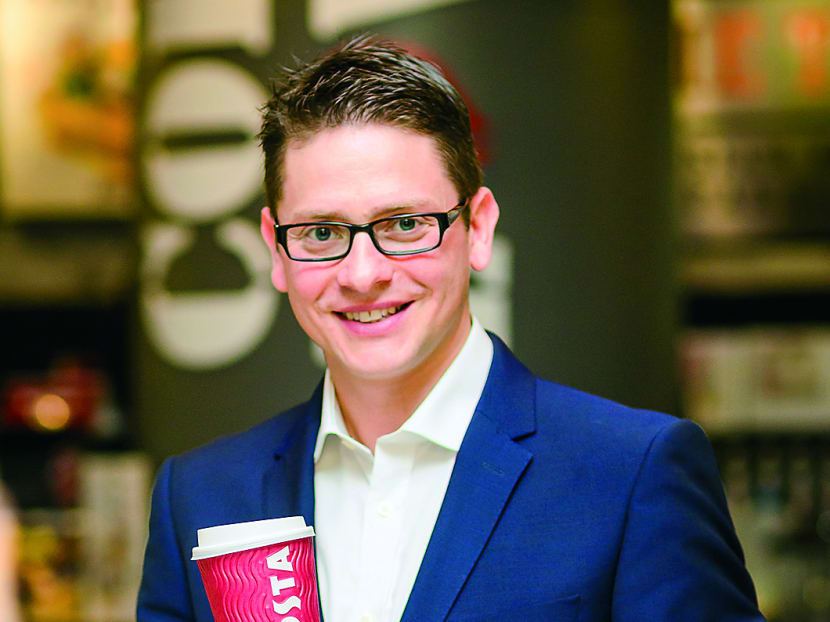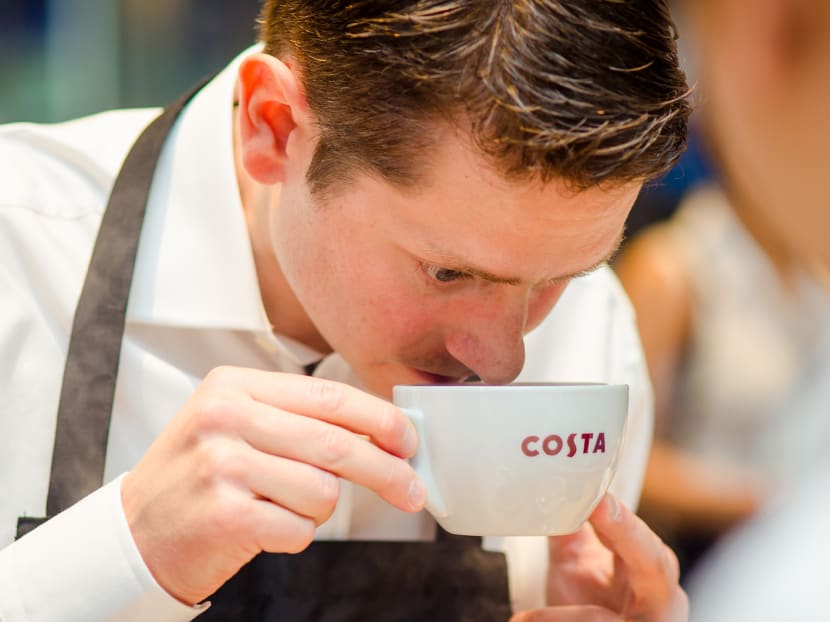Costa’s coffee master spills the beans
An Italian at the helm of a leading chain of coffeehouses in the United Kingdom? Why not? Although his distinct British accent could throw the unsuspecting off, Costa Coffee’s Master of Coffee Gennaro Pelliccia was born in Naples, but has been calling London home since he was five.


An Italian at the helm of a leading chain of coffeehouses in the United Kingdom? Why not? Although his distinct British accent could throw the unsuspecting off, Costa Coffee’s Master of Coffee Gennaro Pelliccia was born in Naples, but has been calling London home since he was five.
“And for 23 years of my life, I’ve worked for Costa Coffee,” the 39-year-old said. “I owe a lot to London.”
Like many Italians, Pelliccia said family ties did play some part in his chosen career.
“Funnily enough, everyone in my family has worked for Costa Coffee at some point,” he shared, explaining how it all started in 1981, when his mother worked for Sergio Costa — he and elder brother Bruno started the business in 1971 — as his personal secretary for a year. (Bruno left to focus on his porcelain business and Pelliccia’s mother followed.) Pelliccia’s father, who made a living in the hotel business, joined Costa Coffee in 1991 as an operations manager after the recession hit the country.
“My first job (at 16 years old) was as a barista working part-time at Gatwick Airport,” Pelliccia said. He graduated in 1997 with a degree in mechanical engineering, but decided to carry on until he found “a proper job”.
“The reason I ended up staying is that I was offered a job as the assistant production engineer and trainer — so I could use my skill a bit in the production ... and running the operation. So there was some sense in that,” he said.
“I began to learn the art of blending, roasting and buying coffee (at the roastery). And that’s when the passion really dialled in and I thought, ‘There are not many people doing this, the company’s growing, what a great opportunity’.”
In 1999, he and then Master of Coffee Gino Amasanti, who had taken Pelliccia under his wing, became the first in the UK to be certified “Italian espresso tasters” by the Institute Of Italian Coffee Tasters.
Costa is also the latest chain to enter Singapore’s coffee market, which some may say is quite saturated. But Pelliccia remains confident that the timing could not be better.
“Although espresso roasting is a very Italian thing, this movement, this wave of artisan coffee (roasted on site) is a very northern European thing that is actually being spearheaded by the Australians (in this part of the world), who are doing a fantastic job,” he explained.
“Costa may be a large brand, but we handcraft our cups of coffee. And 100 per cent of the coffee that we procure in every single market that we trade (for nearly 1,700 stores in 30 countries) is Rainforest Alliance Certified.”
Then there is the question of his tongue being insured for £10 million (S$21 million), which was the result of a taste test, so to speak. “Costa was sick and tired of a myth going around in the UK that all coffee was the same. That nobody could tell the difference between the large brands,” Pelliccia said. “So we commissioned an independent survey. And the results categorically proved that seven out of 10 people preferred Costa’s cappuccino over our nearest competitor. And this was all done via blind taste tests. So we thought, first of all, the myth is gone. Then we thought, for us to raise awareness, ‘Let’s insure the tongue of the guy responsible for safeguarding the quality of our coffee’. It was a phenomenal idea; it was to prove a fact and it has resonated in the UK ever since.”
But how does Pelliccia feel about his tongue being worth more than Heidi Klum’s legs? “It’s the one question I’m often asked and the one I don’t know how to answer,” he conceded.
Q: You’ve tasted coffee from many different origins. Which did you first fall in love with?
A: I remember tasting Kenya AA for the first time. It was a turning point for me … when I realised, wow, there’s a wide spectrum of flavours here that can be discovered. And the fruity, berry notes of the Kenyan coffee, and the acidity levels, blew me away. If coffee can be this good (I thought), let me learn more.
Q: Is it still you favourite?
A: There’s a short list it’s definitely in that bunch.
Q: And the top three in that list would be?
A: We do a Mocha Italia blend, for mass consumption (at Costa) … so I would say the Kenyan, the Columbian and probably certain Guatemalans.
Q: Is there a perfect espresso blend for the mass market?
A: You are drinking it. (Laughs) And I’ll explain it. The last thing I want to sound is arrogant. The Mocha Italia blend that we use in all our stores everywhere in the world is created so that not only is it a great espresso by itself, but when you think that 90 per cent of (our) products have milk in them, the espresso blend has to have enough character to shine through.
Q: And what is a perfect espresso?
A: Not one bean has the character of being good enough by itself to make a great espresso. You’ve got to blend. You can make single origin espresso but it will have a character. By blending, it allows you to increase (grow) its character, to do more jobs. So the Mocha Italia has body because of some of the Robusta coffee used. But because we have more Arabica inside, it also has aroma, flavour, it has caramel notes, toasted bread notes. And that spectrum of flavours cannot come from one bean.
Q: But isn’t great espresso best enjoyed black?
A: Because espresso is the base of all our drinks, I’d be shooting myself in the foot if I said it’s best drunk black. Because a cappuccino by itself is the prefect espresso extraction with perfectly froth milk. Now, you’d be able to tell the difference between our cappuccino and another because of the espresso blend inside.
Q: How do you take yours?
A: Well, yes, I would predominantly have it single, but often with a splodge of milk — macchiato. Just to give it a bit more fluffiness, make it a bit lighter depending on the time of day I’m consuming it.
Q: On its own then, how quickly should an espresso be served and drunk?
A: I love this kind of questions. A perfect espresso to Costa brand standards is 7g of coffee (we’re not shy to use coffee so you can even use 7.5g) per shot. In our shop all our drinks have at least a double shot. We extract it very slowly because you want the water as it is passing through the coffee to spend just the right amount of time to take all the desirable compounds, but not too long where it starts extracting al the undesirable, all the bitter notes. After that, if you are extracting a single espresso, then you want to appreciate it at about 60 to 65 degrees C. And to answer your question, it should take you as long as you want, as long as you are still getting those characteristic notes, which are, first of all, the caramel aroma, toasted bread and that delicate acidity, and that lingering sweet aftertaste.
Q: How can a consumer truly appreciate good coffee?
A: There are few steps. Start by drinking it black, in its pure form without adding anything. And then start investigating single origin coffees; different roast as well — the same coffee roasted lighter and also darker — because this changes the flavour of the coffee. Our blend is medium-roasted and it’s something we’re very proud about. Because it’s only at that roasting level that you can appreciate the nuances of a certain origin or blend. Once you roast too dark and you burn the coffee, you lose all the delicate characteristics. Some rosters do that, though, because not only do you lose some of the positive, it also allows people to hide some of the not-so-good-things about the coffee. We take a risk because when you roast coffee to a medium, you are exposing yourself. But if you buy the right stuff, if you roast it correctly and your baristas handle it correctly, then that’s the recipe for success.
Q: What’s the most enjoyable thing you’ve eaten with coffee?
A: My favourite combination is a double macchiato with a nice croissant or a Danish pastry. Because then the bittersweet notes of the coffee would be enhanced by the sweetness of the pastry. If it’s an afternoon thing, a nice slice of cake.
Q: Also with a macchiato?
A: Being Italian, we don’t put milk in our coffee after 11am. But you know cultures are different. And reasons for consuming are different. I was here last night and couldn’t believe the number of people on the streets at midnight.
Q: What does Costa bring to the table?
A: The artisans are bringing freshly roasted coffee, which is extracted and brewed a certain way, so you get the best flavour. We’ve been doing this since 1971. But we’re doing it obviously as a chain… it’s less romantic. But this is the time for (our global expansion) because of this movement. I fully support their movement because I’m purist. I always tell friends and consumers, if you’re not happy with something, tell the barista. In some cultures, we don’t complain enough. I come from a culture where we complain about everything. Us Italians, if we don’t like it, you’d know about it.





